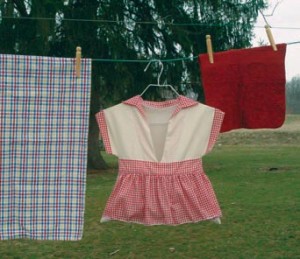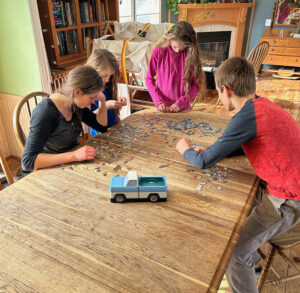Most of us deck the halls and that includes putting a jolly wreath on our front door. But I am rather charmed with using ‘found’ objects to make wreaths to celebrate other holidays year round.
However, the Christmas period and the winter months are the right time to get my indigenously grown essential for wreath projects.
Some people like to use an old wire coat hanger to make their wreath frame. You can then pack straw held in place with rafia to make one kind of frame. Others put in sphagnum moss but this is something that we want to preserve so best to stick to a renewable like stray or hay.
I don’t have a huge supply of wire coat hangers. I’m sort of allergic on principle to using all the chemicals needed in dry cleaning so I’ve no ready source of wire coat hangers.
What I DO have is lots of willow out on our acre.
Winter and early spring is the right time to take willow cuttings.
Living in a perpetually damp climate it’s quick work to make the wreath shape. Florist wire, cotton string or garden binding twine can be used to keep it in shape. The willow does need to be damp to work with it. If you can’t get to your project straight away a quick dunk in the bath tub will make the withies nice and pliable.
But what next to adorn the wreath? It’s traditional to use holly for Christmas. But with my environmental hat on I feel bound to tell you that those shiny red berries are from the female plants. And we need those nice shiny berries from the female plants to make more holly bushes of both gender. If too many nice shiny holly berries land up in Christmas wreaths a generation or so down the line it will be a quaint thing of the past to tell our grandchildren.
So if holly is what you want for Christmas use the male plants. If you want to have the big red burst of colour paint some hazel nuts with water-based red paint. I quick coat of nail varnish will give it a bit of shine.
But look around in nature. Each season offers us wonderful little eye pops that can be put on your wreath form to ring the seasonal changes.
For instance, in December and January we see the first blooms of the year. The spikey gorse bush flowers bright acid yellow blooms that give off the most heavenly scent of coconut and vanilla. Sometimes I use gorse on my Christmas wreath but it certainly is going to adorn the door by February, which is the start of spring in Ireland.
Hawthorn blossom is the traditional blossom for the May Day wreath.
The door is exactly the right place for it as it is considered unlucky to bring hawthorn indoors.
Ribbons or strips of fabric can be used to garnish whatever natural materials you decide to add to your wreath. Nuts can be painted.
Seashells or stones with natural holes in them can be attached. In winter we have sometimes come across abandoned bird’s nests in hedges.
These can be planted up with a seasonal bloom – primroses or violets in spring, petunias and pansies in summer and early autumn.
Some people are really crafty with a jigsaw. You can find templates or shapes that suggest different seasons – pumpkins for Halloween, daffodils for St. David’s Day, a flag for Memorial Day and the 4th of July. If there is an anniversary coming up, use that wreath shape and carry on with the ring thing theme! The same can be said if you want to announce an impending family wedding and incorporate the bridemaids’ dress colours or a few blooms that will feature in the nosegay.
Don’t think that you have to stay with conventional seasonal colour schemes. There is more to Halloween than orange and black! Is there a full moon? That works with the witchy theme and silver is the colour of the full moon. Also remember that you can make little witch’s besoms with found birch twigs and some raffia.
Yellow is the special colour of spring but also look to the purples and blues that are blooming at that time of year. Green is particularly intense at that time of year and is not just for St.
Patrick’s Day. Oh, and if you want to get fun this St. Patrick’s Day, fashion a snake for your wreath as Ireland’s patron saint is credited with banishing them from the country.
Most of the materials you need can be found in nature or can be bought for buttons – ribbon and balsa wood, poster paint and varnish, hay or straw. You might want to start a family tradition of creating a special wreath for birthdays.
Your willow wreath frame will hold up to all weathers. You will need to replace any hay stuffing from time to time.
Homemade wreaths are cheap and cheerful, personal and an awful lot of fun to make.

































